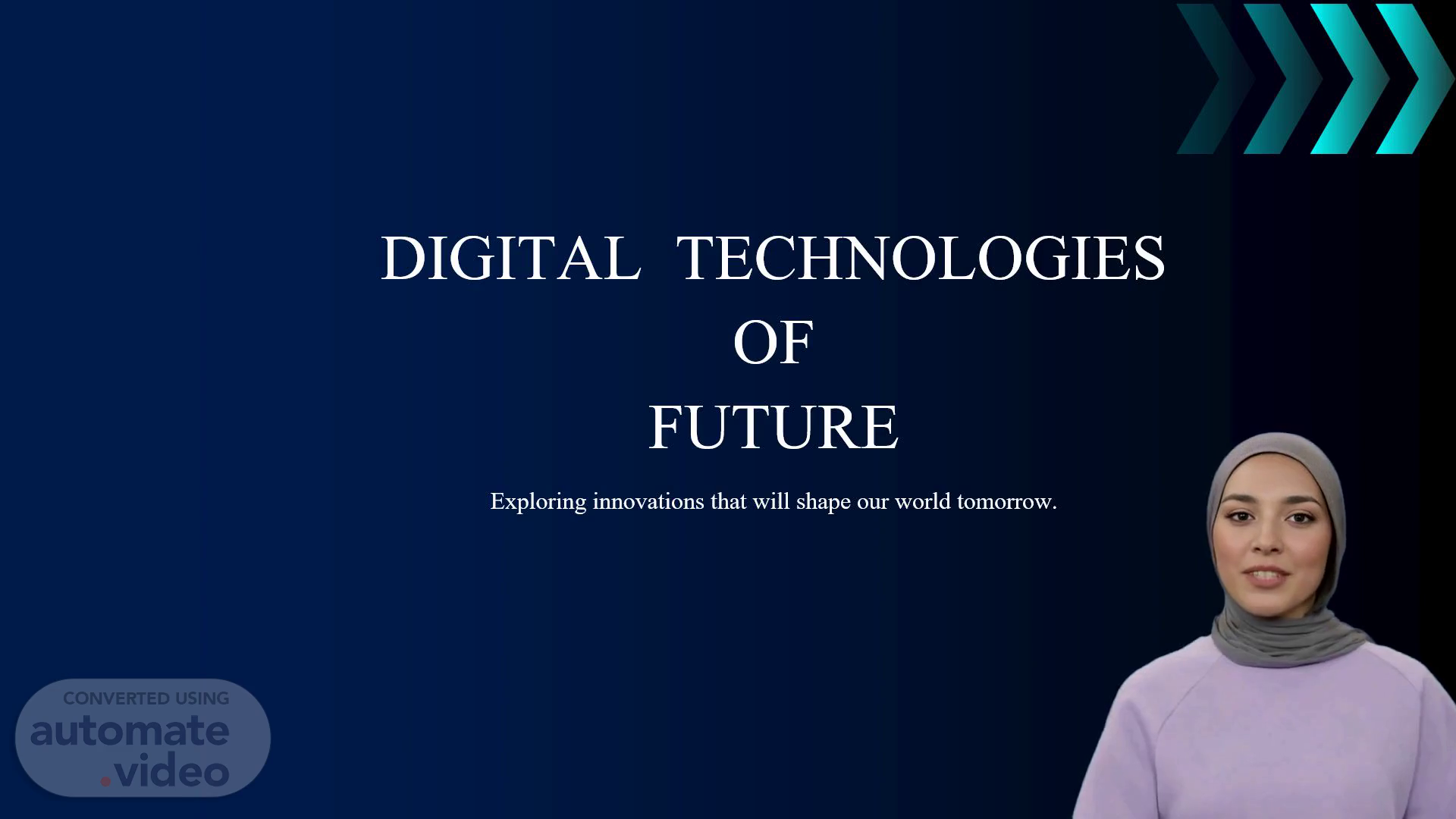Scene 1 (0s)
[Virtual Presenter] Welcome to the Digital Technologies of Future presentation. We are here to explore the innovations that will shape our world tomorrow. Let us dive in!.
Scene 2 (9s)
[Audio] The impact of technology on business is significant. With the rise of artificial intelligence and machine learning, companies are able to make more accurate predictions, automate tasks, and gain valuable insights from their data. This has led to increased efficiency, productivity, and competitiveness. Furthermore, the digital revolution is changing the way we do business, enabling new forms of communication, collaboration, and commerce. As we move forward, it's essential to consider how these advancements will shape the future of business and what opportunities they present..
Scene 3 (41s)
[Audio] Businesses can operate more efficiently due to automation and streamlined processes, which lead to increased productivity. Companies can automate repetitive tasks using technology, allowing employees to focus on high-value activities. This leads to improved efficiency, reduced costs, and enhanced competitiveness..
Scene 4 (1m 2s)
[Audio] (A-I ) and machine learning are two interconnected fields that have the potential to transform various aspects of our lives. (A-I ) refers to the broader field of developing intelligent agents that can perceive their environment, reason, learn, and take actions to achieve specific goals. On the other hand, machine learning is a subset of (A-I ) that focuses on algorithms that enable computers to learn from data and improve their performance over time without explicit programming. This has led to numerous opportunities, including enhanced decision-making, automation of tasks, improved efficiency and productivity, personalized experiences, and advancements in healthcare. However, there are also threats associated with (A-I ) and machine learning, such as job displacement, ethical concerns, data privacy and security issues, lack of transparency, and dependence on data quality..
Scene 5 (2m 0s)
[Audio] Netflix's recommendation system utilizes advanced machine learning algorithms to analyze substantial amounts of user data, including their viewing history, ratings, search queries, and device information. This analysis allows the company to offer users personalized content recommendations, resulting in enhanced user engagement, improved customer retention, and increased revenue..
Scene 6 (2m 25s)
[Audio] The digital revolution has brought about a fundamental change in how businesses operate, interact with customers, and innovate. With the advent of digital intelligence, organizations can now harness the power of data to gain real-time insights, drive innovation, and enhance agility. This fusion of advanced analytics, big data, and artificial intelligence enables companies to uncover hidden patterns and trends in customer behavior, market dynamics, and operational performance. By leveraging this information, businesses can identify emerging opportunities and customer needs, fuel product and service innovation, and adapt quickly to market changes and disruptions..
Scene 7 (3m 8s)
[Audio] Businesses can benefit from a data-driven culture by making informed decisions based on evidence rather than intuition. This enables them to optimize performance, enhance customer experience, and gain a competitive edge. However, this also comes with cybersecurity risks such as data breaches, ransomware attacks, and phishing attempts. Moreover, remote work capability can offer increased flexibility and reduced operational costs but may also exacerbate the digital divide and create unequal access to technology. Furthermore, customer-centric models can provide personalized experiences and real-time feedback but may also lead to dependence on technology and its associated threats..
Scene 8 (3m 51s)
[Audio] The rise of automation has led to a growing need for employees to reskill and acquire digital competencies, including data analysis, artificial intelligence, and machine learning. This enables them to remain relevant in the job market. Furthermore, (A-I ) can collaborate with humans, allowing them to focus on higher-value activities..
Scene 9 (4m 13s)
[Audio] Investing in (A-I ) and data capabilities is crucial for digital success. This involves building a robust data infrastructure to collect, store, and process valuable insights. Advanced analytics tools should be implemented to uncover hidden patterns and trends, empowering decision-making through a data-driven culture..
Scene 10 (4m 33s)
[Audio] The digital revolution is transforming industries and redefining the future of business. To stay competitive, organizations must adapt to these advancements. This requires embracing digital transformation, harnessing the power of data, prioritizing cybersecurity, cultivating a digital-savvy workforce, and fostering innovation. These key takeaways highlight the importance of adapting to the changing business landscape and investing in the future of work.
Scene 11 (5m 1s)
Q&A. ANY QUESTIONS ?. page 11.
Scene 12 (5m 8s)
[Audio] Invest in your digital future to stay competitive and resilient in a rapidly evolving market..
